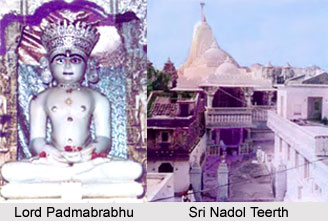 Shri Nadol Teerth located in Rajasthan is a Jain pilgrimage centre. The teerth kshetra is situated in centre of Nadol Village. The temple is dedicated to Lord Padmaprabha, Sixth Jain Tirthankara.
Shri Nadol Teerth located in Rajasthan is a Jain pilgrimage centre. The teerth kshetra is situated in centre of Nadol Village. The temple is dedicated to Lord Padmaprabha, Sixth Jain Tirthankara.
History of Shri Nadol Teerth
As per history Shri Nadol Teerth dates back to the ancient times. According to references the city was earlier named as Nandpur or Nardulpur. The teerth is believed to be before time of King Samprati. Acharyashri Mandevsuriji had composed Laghu Shanti Stotra here in Vikram Samvat Era 300. The stotras are still recited. The Akhand Jyoti is kept since 1775 years. It is believed that Bhandari and Kothari Gotra had originated from this place. The idol of Lord Padmabrabhu is believed to possess miraculous powers and is visited by thousands of Jains and non Jains from far off places. They come here to offer their prayers to the Lord and receive his blessings. It is believed that if prayed with all devotion the Lord fulfils the wishes of the pilgrims.
Temple of Shri Nadol Teerth
The idol of Lord Padmabrabhu is installed in the temple of Shri Nadol Teerth. The temple has been magnificently decorated with intricate artistic designs. The creative temple work boast about the skills of the craftsmen. The walls and pillars of the temple are adorned with specimens of ancient art and paintings. The idol of the Lord is white in colour and is seated in a padmasana posture. The idol has been beautifully carved from a single stone and looks very beautiful. The smiling face of the Lord looks very calm and serene. Apart from this there are three other ancient temples located here. These temples have also been attractively decorated and are worth visiting.
The Temple of Sri Nadol Teerth organizes many annual gatherings and functions that are celebrated with much enthusiasm. There are provisions for dharamshalas or rest houses for the pilgrims that are well equipped with all modern facilities. There are also facilities for Upashrays, Ayambilshala and Jnanabhandar. The teerth being situated amidst beautiful natural surroundings attracts many pilgrims. The surrounding greenery and the beauty of the teerth mesmerize and fascinate the pilgrims. The calm and tranquil village environment makes it a perfect place for religious activities. The kshetra is well connected to road, rail and air. Taxi services and bus services are easily available here. The bus stand is located at Rani at a distance of 18 km. the nearest railway station is located at Rani that is at distance of 18 kilometers and Falna at a distance of 50 kms. The closest airport is situated at Udaipur and Ahmedabad.




















